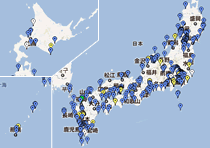ブログ
震災漂流物ニュース:7 tsunami-swept boats found in Hawaii(The Japan News)
2015/05/17
JEANへのインタビュー記事です。
The Yomiuri Shimbun Seven fishing boats believed to have been swept away by the March 2011 tsunami have washed ashore in Hawaii from February to April, according to an environmental nongovernmental organization.
The Japan Environmental Action Network (JEAN) said another fishing vessel had turned up on the coast of Miyakojima island in Okinawa Prefecture.
The boats likely drifted on the Pacific Ocean for some time before riding a subtropical gyre current, the organization said.
Other similar ships may be found in the future, sources said.
JEAN has been investigating the origins of the wreckage. Using vessel numbers, it has identified two of the seven boats as those of fishermen in Miyagi and Fukushima prefectures.
The Tokyo-based organization is now trying to trace the five remaining boats.
The fisherman in Miyagi Prefecture, who abandoned his job due to his age, said he did not want the boat returned to him.
Meanwhile, JEAN said it has been unable to contact the boat owner in Fukushima Prefecture.
The boat found in March on Miyakojima island was confirmed as formerly belonging to a fisherman in Miyagi Prefecture.
While a conspicuous number of fishing boats drifted to the Pacific coast of North America around 2012, only a few have emerged on the coasts of Hawaii and Okinawa.
It is unusual that eight boats were found on the coasts within a three-month period, according to JEAN.
One reason the vessels stayed afloat is that many of them are made of fiberglass-reinforced plastic, a material that does not sink easily.
According to Environment Ministry estimates in 2012, about 5 million tons of debris from houses and boats were dragged out to sea following the Great East Japan Earthquake.
About 70 percent of the debris sank to the seabed due to the characteristics of the materials, and the remaining 1.5 million tons is believed to be adrift on the ocean. Ships including fishing boats likely comprise about 1,000 tons.
"There's a subtropical gyre in the northern Pacific Ocean that flows clockwise," Kyushu University Prof. Atsuhiko Isobe explained.
The Kuroshio current forms a western boundary of the subtropical gyre.
The subtropical gyre has two paths: a current that flows eastward from Japan and moves southward around Hawaii, and another that travels toward North America and then flows southward along the coast. Both currents turn westward and return to Japan after traveling around the south of Hawaii.
Given that the outside of an ocean current flows fast and the inside slow, quake debris from Japan can reach North America in a few months when it rides along the outside of a current.
However, when debris rides along the inside, it can remain adrift on the ocean for a long period of time. But debris can sometimes appear on the coast during storms, when the current tends to run faster, he said.
"These boats may still have some value for those who lost everything in the tsunami after the quake. We'll do our best to return the boats to their owners," said JEAN Secretary and Director Azusa Kojima.Speech
トラックバック
このエントリーのトラックバックURL:
https://www.jean.jp/cgi-bin/mt/mt-tb.cgi/130




